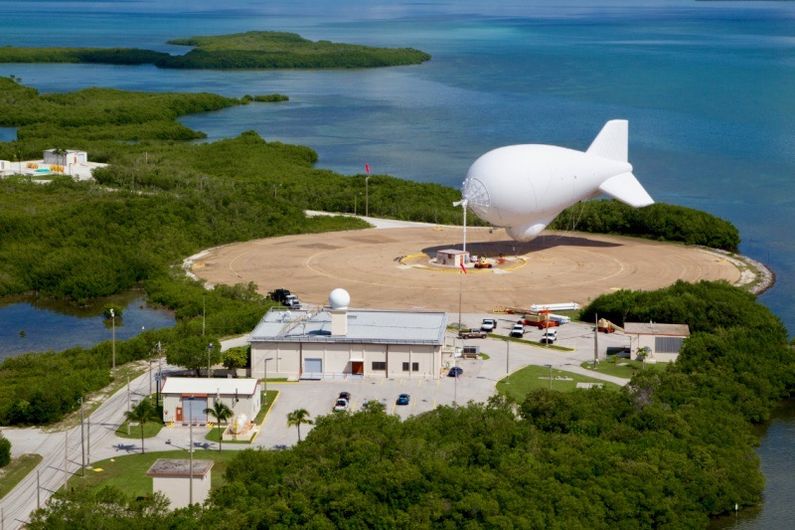Cudjoe Key Air Force Station
|
Cudjoe Key Air Force Station (1960-2013) - A Cold War U.S. Air Force Radar Station located near the town of Cudjoe Key in Monroe County, Florida. The radars at this station were operated from tethered balloons to provide a "look down" view of low flying aircraft and ships. Initially assigned a SAGE System ID of Z-399 and later a JSS System ID of J-08 and a TARS ID of B-94. Turned over to the U.S. Customs and Border Protection agency in 2013.
HistoryThis site was initially established in June 1959 by the U.S. Army to track missiles traveling over the Eglin Gulf Test Range. The Air Force assumed operations in 1960 and the site became Cudjoe Key Air Force Station. Beginning in May 1967 Cudjoe Key AFS was used as a radio facility and SIGINT collection station by the USAF Security Service for a classified mission This site was responsible for collecting SIGINT from Cuba and coordinating its activities with airborne SIGINT collection activities over Cuba and other intelligence operations in the region.   In September 1973 the station became the host for a balloon-borne radar surveillance system, with two DPS-5 radar systems. The DPS-5 was a General Electric S-band, single-channel surveillance radar. It was a lightweight system (weighing just over a 1,000 pounds) with a parabolic antenna that rotated at 5 rpm. The system had a range of about 150 nmi from a hovering altitude of 12,000 feet. The Tethered Aerostat Radar System carried the DPS-5 S-band radar with the CFAR/MTI . This system was operated mostly with contract personnel. The concept was that this look-down radar could monitor low flying aircraft and even ship traffic. In 1974 construction began on the two circular launch/tether concrete pads. In December 1974 Random operation of this balloon-borne radar(Seek Skyhook) began at Cudjoe Key. The system kept watch on the Florida Straits between Cuba and the United States. In 1978 the U.S. Air Force set up the first Tethered Aerostat Radar System (TARS) site in Cudjoe Key, Florida. TARS consists of four major components: the aerostat balloon and airborne support equipment; the radar payload; the tether and winch system; and the ground station. The first Aerostats were assigned at Cudjoe Key in December 1980 with the original 250,000-cubic foot aerostat balloons and the DPS-5 radar system. In 1982 Cudjoe Key Air Force Station was being supported by operating location OLAM, 20th Air Defense Sector and connected to the Fort Lee SAGE Direction Center DC-04 with a SAGE ID of Z-399. The airborne equipment listed in 1982 included the Aerostat with the DSP-5 radar package and telemetry/command systems. Ground equipment included a FYQ-47 common digitizer to transmit the radar and IFF/SIF tracks back to the Fort Lee SAGE Direction Center and UPA-62 manual scopes. Personnel at the station included 65 RCA contractor personnel, 2 USAF quality monitors and 10 USAF Operations personnel with SMSgt Lister as the USAF OL Chief. With the closure of the Fort Lee Direction Center on 1 Mar 1983, control switched to the Tyndall AFB ROCC (SEADS) and Cudjoe Key AFS became a part of the JSS System with a JSS ID of J-08.
In 1990, the U.S. Government had created TV Martí to broadcast Spanish language television programming to Cuba. TV Martí started broadcasting on 27 Mar 1990 from a transmitter aboard one of the Aerostat balloons tethered at Cudjoe Key. "Fat Albert" as the Aerostat was known was subject to the weather and had to be hauled down when conditions were unfavorable. The balloon broke loose in 1991 and embarrassingly drifted into the Everglades. On 16 Jul 2003, Lockheed Martin received a $4 million order to deliver a second U.S. Air Force TARS and L-88(V)3 radar for installation at Cudjoe Key, FL. On 9 Jul 2005 Hurricane Dennis passed by Cudjoe Key with 113 mph winds striking the AFS. Both the Air Force balloon and the TV Martí balloon were shredded. The ground crews were able to get the radar and the radio transmitter out of the balloons safely but the balloons themselves were shredded. The Air Force balloon was replaced but the Aerostat version of TV Martí ended. On 1 Jul 2013, U.S. Customs and Border Protection (CBP) assumed official program and contract management responsibilities and assumed all funding requirements starting in FY 2014. TARS OperationsThe TARS program at Cudjoe Key now uses two Lockheed Martin L-88(V)3 radar-equipped 275K Aerostats. All radar data is transmitted to the ground station then digitized and fed to the various control centers for display. The ground station is where a flight director, seated before banks of meters and television screens, monitors the aerostat's performance. A doppler weather radar, wind profiler, and ground weather station are installed at each site to support flight operations. Each site also obtains up-to-date forecasts and weather warnings from the Air Force Weather Agency. Operators launch the aerostat from a large circular launch pad containing a mooring system at the center. The mooring system contains a large winch with 25,000 feet of tether cable. During the launch sequence, the winch reels out the tether until the aerostat reaches operational altitude. When the aerostat is lowered, it is secured to a mooring tower. While moored, the aerostat weather vanes with the wind. Aerostat power is provided by an on-board, 400 Hertz generator with a 100-gallon diesel fuel tank. All systems, to include the generator are controlled via an aerostat telemetry link.
Current StatusThe former U.S. Customs Service (now U.S. Customs and Border Protection) assumed responsibility for the operation and maintenance of the systems in 2013. A review of satellite images in Google Earth shows the Aerostat balloons in the air between 2003 and 2017 and a satellite image in February 2003 of both Aerostats in the air.
See Also: Sources:
Links:
Visited: No
| ||||||||||||||||||||
